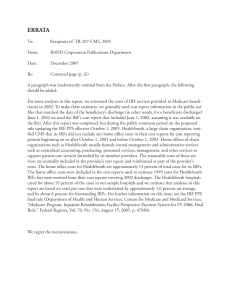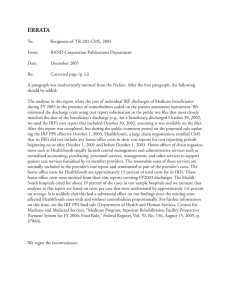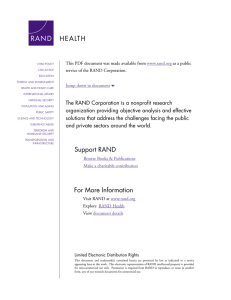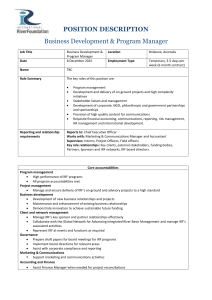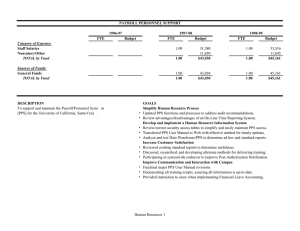6 om as a public service of the RAND Corporation.
advertisement
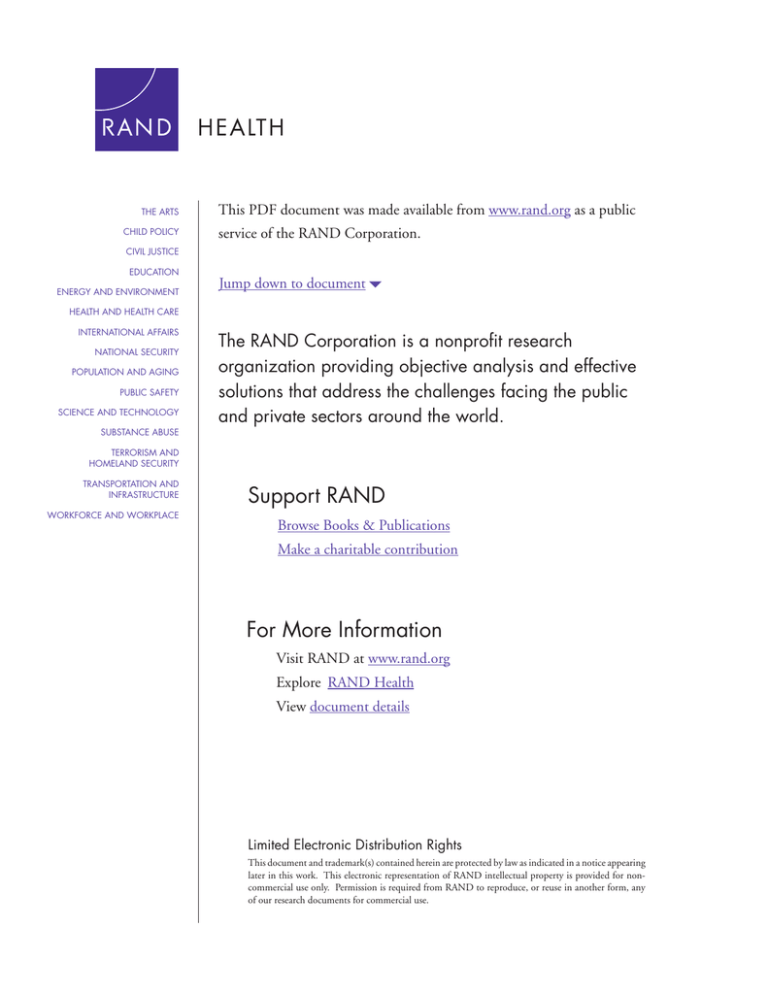
THE ARTS CHILD POLICY This PDF document was made available from www.rand.org as a public service of the RAND Corporation. CIVIL JUSTICE EDUCATION ENERGY AND ENVIRONMENT Jump down to document6 HEALTH AND HEALTH CARE INTERNATIONAL AFFAIRS NATIONAL SECURITY POPULATION AND AGING PUBLIC SAFETY SCIENCE AND TECHNOLOGY SUBSTANCE ABUSE The RAND Corporation is a nonprofit research organization providing objective analysis and effective solutions that address the challenges facing the public and private sectors around the world. TERRORISM AND HOMELAND SECURITY TRANSPORTATION AND INFRASTRUCTURE WORKFORCE AND WORKPLACE Support RAND Browse Books & Publications Make a charitable contribution For More Information Visit RAND at www.rand.org Explore RAND Health View document details Limited Electronic Distribution Rights This document and trademark(s) contained herein are protected by law as indicated in a notice appearing later in this work. This electronic representation of RAND intellectual property is provided for noncommercial use only. Permission is required from RAND to reproduce, or reuse in another form, any of our research documents for commercial use. This product is part of the RAND Corporation technical report series. Reports may include research findings on a specific topic that is limited in scope; present discussions of the methodology employed in research; provide literature reviews, survey instruments, modeling exercises, guidelines for practitioners and research professionals, and supporting documentation; or deliver preliminary findings. All RAND reports undergo rigorous peer review to ensure that they meet high standards for research quality and objectivity. Changes in Patient Severity Following Implementation of the Inpatient Rehabilitation Facility Prospective Payment System Susan M. Paddock, José J. Escarce, Orla Hayden, Melinda Beeuwkes Buntin Supported by the Centers for Medicare and Medicaid Services The analyses upon which this publication is based were performed under Contract 5002004-00033C, entitled “Inpatient Rehabilitation Facility Prospective Payment System Monitoring, Access, and Refinements,” funded by the Centers for Medicare & Medicaid Services, Department of Health and Human Services. The contents of this publication do not necessarily reflect the views or policies of the Department of Health and Human Services, nor does the mention of trades names, commercial products, or organizations imply endorsement by the U.S. government. The author assumes full responsibility for the accuracy and completeness of the ideas presented. The RAND Corporation is a nonprofit research organization providing objective analysis and effective solutions that address the challenges facing the public and private sectors around the world. RAND’s publications do not necessarily reflect the opinions of its research clients and sponsors. R® is a registered trademark. A profile of RAND Health, abstracts of its publications, and ordering information can be found on the RAND Health home page at www.rand.org/health. © Copyright 2006 RAND Corporation All rights reserved. No part of this book may be reproduced in any form by any electronic or mechanical means (including photocopying, recording, or information storage and retrieval) without permission in writing from RAND. Published 2006 by the RAND Corporation 1776 Main Street, P.O. Box 2138, Santa Monica, CA 90407-2138 1200 South Hayes Street, Arlington, VA 22202-5050 201 North Craig Street, Suite 202, Pittsburgh, PA 15213-1516 RAND URL: http://www.rand.org/ To order RAND documents or to obtain additional information, contact Distribution Services: Telephone: (310) 451-7002; Fax: (310) 451-6915; Email: order@rand.org ix Executive Summary Background In response to the Balanced Budget Act of 1997, the Centers for Medicare and Medicaid Services (CMS) implemented a prospective payment system for care provided by hospital inpatient rehabilitation facilities (IRFs) to Medicare beneficiaries beginning on January 1, 2002. The goals of the IRF prospective payment system (IRF PPS) include enhancing access to IRF care by more closely aligning Medicare payments with actual IRF costs (by compensating IRFs based on their case mix -- the mix of medically severe and less severe cases being treated in IRFs) and controlling Medicare’s inpatient rehabilitation expenditures. The IRF PPS was implemented in part as a response to concerns about access to care under the earlier payment system, which was based on historical costs rather than case mix. One implication of using historical costs was that rehabilitation facilities could not recover extra costs if their case mixes shifted to include more severe patients who are costlier to treat. IRFs therefore had an incentive to accept more patients with less severe conditions, whose care is less expensive, and to restrict the access of patients with more severe conditions. However, similar concerns are presented by the structure of IRF PPS, which also gives facilities a more subtle incentive to accept less severe patients (e.g., patients with higher functional status) within each case mix group and comorbidity tier. Study Purpose and Approach The purpose of this analysis is to examine the effects of the IRF PPS on patient access to care, and to determine if access for more severe patients cases is being restricted. To examine such effects, we first developed three hypotheses, based on prior x experience with the implementation of prospective payment systems. Our work was designed to test the hypotheses. The three hypotheses are: 1) Following the IRF PPS implementation, fewer patients with particularly costly conditions will be admitted from acute care. 2) Cases having higher resource use requirements (i.e., more severe cases) will have reduced admission rates under the IRF PPS. Specifically, relatively severe cases within case mix and comorbidity groups may experience reduced access to IRF care. 3) Patients will receive a lower intensity of care under the IRF PPS. We compared indicators of patient access measured before and after the IRF PPS implementation. We focused primarily on measures of the amount of care delivered, such as length of stay and average cost per case, and patient characteristics, such as functional status, mortality, and age, to understand whether utilization remained steady under the IRF PPS and whether IRFs selected less expensive and less medically severe cases after implementation of the IRF PPS. We constructed several measures of severity to capture these effects. Comparison of data from periods before and after the IRF PPS is complicated by the fact that some observed trends in key measures, such as length of stay, are confounded by other changes. Moreover, the instructions provided for collecting data using the FIM™ instrument were changed and clarified just prior to the IRF PPS implementation, limiting the comparability of FIM™ data across time periods. Thus, our severity measures relied heavily on data from the IRF patients’ preceding acute care stays, since we judged that the IRF PPS implementation should not affect coding in acute care settings. Our analyses of conditions specified on the basis of their costliness (i.e., ventilator dependence, dialysis, and organ transplant) used data from the universe of IRF cases from 1999 through 2002. The remaining analyses that define patient severity relative to xi that of similar patients require the use of the FIM™ scores in order to classify patients into groups based on their FIM™ motor and cognitive scores, condition, and age. Results Hypothesis 1: Fewer cases with costly conditions. Overall, we found no evidence that patients treated at IRFs were appreciably more or less likely to have specific, costly conditions following implementation of the IRF PPS. Hypothesis 2: Reduced admission rates for more severe cases. There were only slight differences between the percentages of relatively severe cases pre- versus post-IRF PPS. In general, patients under the IRF PPS were more severely ill than those prior to the IRF PPS. Cases under the IRF PPS also had lower probabilities of death. This result, coupled with the greater cost per case requirements, suggests that better functioning patients are increasingly being seen in IRFs. Cases were predicted to have similar functional status, given their case mix, pre- versus post-IRF PPS implementation. Hypothesis 3: Lower intensity of care. A decrease in the average length of stay under the IRF PPS was observed. This could be an indication that IRFs have succumbed to “moral hazard” and are reducing intensity of care. However, this seems to be part of a longer-term trend. Length of stay has been trending downward throughout the study period (1999 to 2002), with the trend moving further downward after 1999. These overall trends do not suggest any dramatic effects on patient access from the implementation of the IRF PPS. The decline between 1999 and 2002 in length of stay appears to have been part of a trend that began prior to 2002. It is possible that changes in resource use could have occurred in anticipation of the IRF PPS or in response to other post-acute care payment systems that went into effect around that time. Any future refinement of the IRF PPS might need to account for the discrepancy between required and realized (observed) resource use. Such variability in trends from year to year warrants continued monitoring of the effects of the IRF PPS.

